Overview
You’re ready to leave for your long-awaited adventure; your backpack is set, your pieces of equipment are well packed, you’ve kept your favorite snacks, and you’re walking to grab the paddle board.
‘Hi there, but I am not ready for the trip!’ says the board. And you recall the time you last went on a trip and forgot to clean them. You cannot compensate for this mistake. But what you can do is not repeat the same mistake again.
Nobody wants to neglect these things. I get it. Nobody wants to ruin their outing. I understand. But there are essentials you need to take care of. Yeah, I know you wanted to burn those calories before your neighbor did. So let’s get you on track; we got this, homie!
You can enjoy surfing on the stand-up paddle boards (SUPs) as much as you want, but always be sure to store them properly. Don’t just lay it down anywhere because you were so tired after the activity and could not take care of it. The neighbor will win.
Conditions for Storing Your Paddle Board

The paddle board size is 10 feet long with a weight of 20 plus pounds. For something this big, it can be quite a job to store them. Whether an inflatable or non-inflatable paddle board, an expensive purchase like this deserves great care for its quality to last as much as possible.
Ideally, the temperature recommended for storing paddle boards is 40-110 Fahrenheit. It is best to store it in a garage space that is clean dry, and protected from extreme conditions. Doing otherwise will ultimately have a negative impact on them. Also, ensure to avoid pressure points while storing your paddleboards.
Paddle boarding is great fun. In this article, we will talk all about the storage of your paddle boards and their methods. So grab the snacks you are craving; we have quite an interesting article for you to read. After all, you need your board to be in tip-top shape.
Where To Store Your SUP?
Regardless of the place where you decide to keep your stand-up paddle board, certain factors are necessary to consider in every case:

Exposure to Sunlight
Not a good idea! Limited exposure to the sun is what your board needs. The UV rays can harm the appearance and structure of your stand-up paddle boards. Therefore avoid direct sunlight on the board.
Moisture
Try avoiding moisture at any cost. They are harmful in ways you would not expect. A wet environment can never be a good friend to the SUP. Resistance to moisture will help stop mold growth and mildew on your SUP board’s surface.
Extreme Temperatures
Protecting your board’s outer shell from extreme heat or cold will keep it from degrading. Harsh weather is the enemy of your SUP board.
We have laid down points as to what environment is best suitable for the protection of your SUP board. Now, let us see what locations are recommended for them.
Locations to Store Your Paddle Board
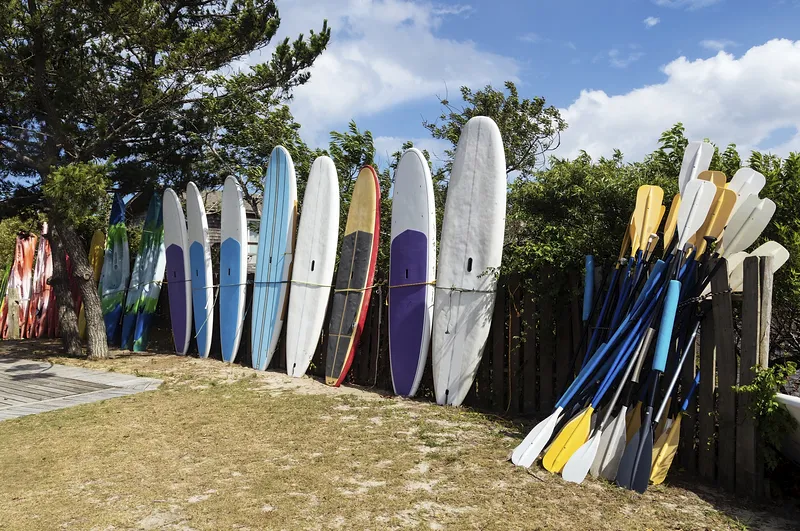
After you use them, you need to store your paddle board correctly. To store them well, you need a location that can treat your paddle boards well.
Indoor Storage
Storing your SUP indoors is the safest option; it could be in a shed or a garage. The majority of indoor rooms are effective at shielding SUPs from extreme heat, moisture, and sunlight. If you like the aesthetic of your board, you can keep it in your lounge, mounted on your wall.
Outdoor Storage
Keeping a large board indoors could be challenging. You can keep your SUPs outside, but safety measures should be taken in order to guard them against the elements. A deck or under the wings of a roof are suitable places to store paddle boards.
If you are thinking about outdoor storage, seek places that have the following in order to provide protection to the board:
Shade
The board will be shielded from harmful UV radiation or sunlight in a shaded spot. Your safest alternative is a tarp that covers the full length of the board and is weather-resistant. To avoid mold and fungus growth, hang it above the board instead of wrapping it.
Protection From the Elements (Rain or Snow)
It’s crucial to ensure that your board has no direct contact with the ground when storing it outside. Your board’s polish and the shell will be harmed by contact with rough surfaces and dirt. For this, a weather-resistant tarp is essential. Wrap the paddle board with the tarp and make sure it collects no rain.
Ways to Store your SUPs
Take care of your paddleboards. Religiously! You cannot let them be and think they are protected. Structural integrity is essential. Positioning these boards is as important as anything else. Let us put forward ways you can keep your paddle board secure.
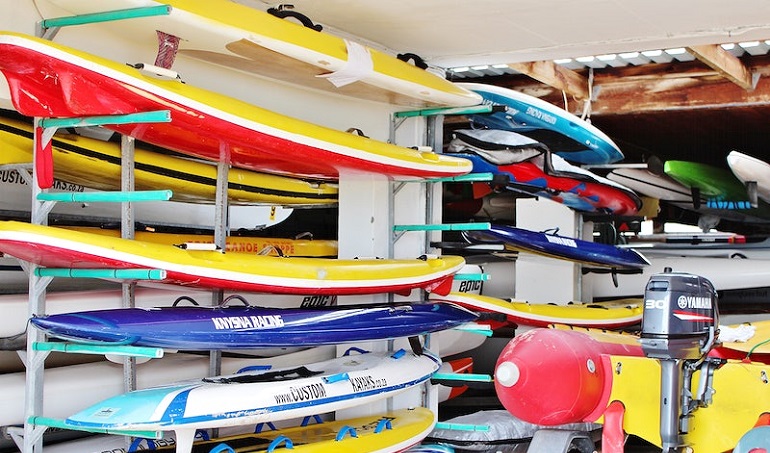
On a Rack
Paddle-board racks make storage a breeze. The best aspect is that there is no restriction on the number of boards when mounting on a wall rack. There are racks that only hold one board, but there are also sets that hold multiple boards.
Although there is one thing to keep in mind, weight distribution should always be even. Without it, your board would bow to the side that is being mismanaged, and then, my friend, we have a problem!
Therefore, ensure that it’s properly centered and weight is maintained at various parts throughout. You can manage this by using wide nylon straps. Also, check your storage rack; it should be stable.
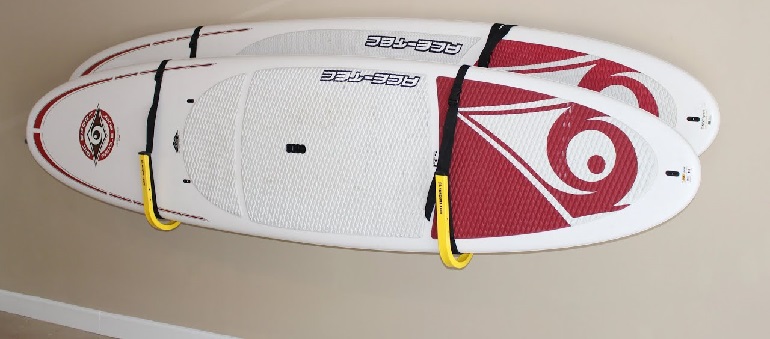
Suspended
To protect the hull of your boat from damage, suspension systems are a great idea. Hang the board with the hull facing up to the ceiling to maintain its strength and durability. A suspension system can be purchased online or at a sporting goods store. You can also design your own using wide webbing straps.
Leaning
Leaning your paddle board against a wall is another option if money is tight. Again, this is an easy and affordable way to store your board in a lot of accessible locations.
Lay your SUP board down on its side or prop it up on its tail. Avoid leaning a paddle board on its nose, as this can harm them and make them dysfunctional. Also, direct contact between the board and floor space is not ideal.

Use a cushion between the floor and your SUP to keep the board in place. A traction pad can also be attached to the floor and the wall where you will be leaning your board. It will further limit the possibility of slipping or toppling over.
Extra Tips on How To Store a Paddle Board
You can place your stand-up paddle board in any of the ways mentioned above. But you need to thoroughly check for a few things before you close the day for them. Below are some extra tips for storing your board.
Rinse
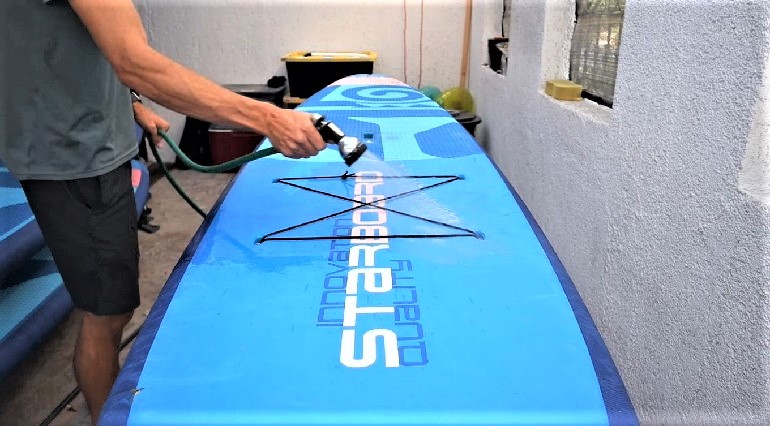
Always rinse your board at the end of the season. Rinsing your paddle board after every trip to the beach is a good idea but not entirely necessary. You can rinse it thoroughly when you plan to store it for a longer period. Otherwise, the abrasion of the beach, sand, and salt can damage the board over time.
Cleanse It
It is advised that you use a natural biodegradable cleanser. This prevents any strong chemicals from damaging your board. Also, avoid scrubbing the entire board too hard to prevent the traction pad from any injury.
Dry It
Dry the paddle board before storing it to remove any internal moisture (for inflatable stand-up paddle boards). If you are going to use it often, not being completely dry is not a concern. But if it’s going to be long-term storage, make sure to dry it out. You do not want bacterial growth on your board.
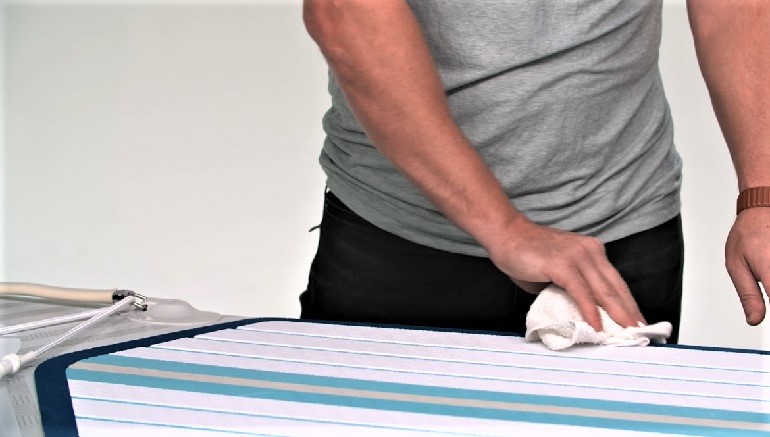
Fin
Fins for SUP are a crucial component of any paddle board setup. If you do not have fins, your board will begin to flip sharply with every turn. And will make the paddling experience worthless.
Therefore always remove the fins from your board before storing it to save them from damage or deformation. Without them, your boards won’t be stable enough to ride you.

Inflatable boards (iSUP)
For inflatable SUP storage, you can avoid permanent creases and deformations. You can do it by keeping the paddle board inflated (slightly by around 5 pounds per square inch) and storing it like a solid board.
Distribute weight evenly, especially if you are planning to lean it. If you do not do this, your inflatable paddle board might deform. Therefore do not put unequal weight on pressure points.
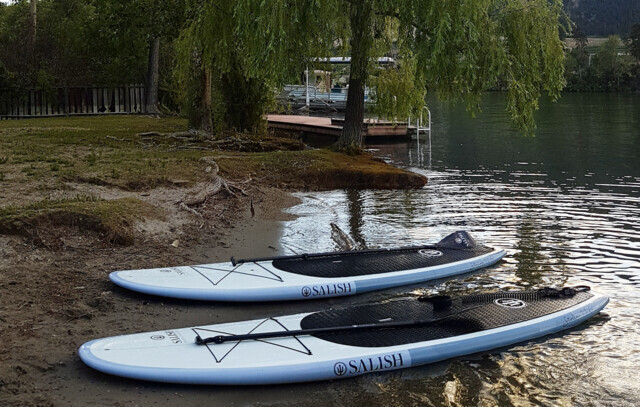
The inflatable paddle boards have the ability to get small. Therefore if space is at a premium, pack it in board bags and deflate it completely by:
- Keeping the valve open.
- Making sure that the board is dry and spotless.
- Not packing the inflatable board too tightly (loosely rolled up is ideal)
- Storing your board somewhere dry and cool (ideally indoors)
These are the finest and highly recommended storage solutions. Whether it is short-term storage or long-term, these precautions will extend the life span of your paddleboards.
What Is the Best Way To Store My SUPs in the Garage?
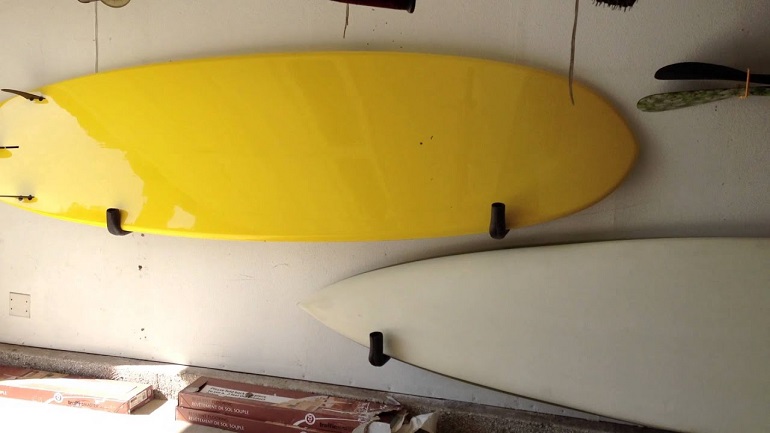
A garage storage or shed should be your next best option if you don’t have enough capacity in the basement. Of course, it has less foot traffic—the lesser the traffic, the lesser the fear of bumping into it.
Paddle boards are best kept in garages on a freestanding rack, a wall rack, or hung from the ceiling. Exposure to the sun, rain, and wind can permanently harm your paddle board. Additionally, when not in sight, you run the danger of your board being stolen.
But the question here is, ‘Can we store inflatable paddle boards in a hot garage?‘
Well, anything above 100 degrees Fahrenheit, and there you go! Say goodbye to your paddle board. You will probably need to shift your board to a different room if the garage is not well-insulated or has a furnace. Reason?
It is simple! Due to heat exposure, the heat inside can expand and could force your inflatable SUP to burst.
Theft Protection
After you have purchased your stand-up paddle board, you need to secure it in many ways. Not only storing your board but also protecting it from theft is one of the main things.
Security System
You don’t have to hide it. But it’s not something you should leave out for everyone passing by to see – and maybe steal. The safest choice is to secure your garage with some form of security system. It can be as simple as a chain and lock or a security wire.
Fin or Plug Bar
If indoor storage is not possible, just cover the paddleboard and tie it to any tangible thing in your yard. You can also thread a strong, durable security cable to the fin box or the leash plug bar.
Car Rack
A secure car roof rack is an excellent purchase if you travel frequently. Car racks are a great way to protect your unattended board.
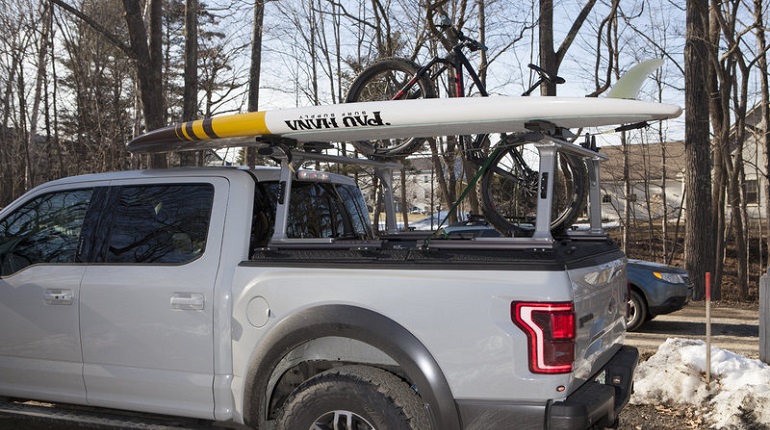
Conclusion
Nothing can damage your paddle boards if you know how to take care of them. It can be tricky as a paddle board beginner but adopt one of the ways mentioned above. You will learn gradually if you really want to make sure your investment is safe.
Just be aware of the surroundings you are choosing as a home for your paddle boards. High temperatures can be a threat to the storage and core materials of your board. Therefore, your paddle board storage method should be foolproof.
You can have all the fun you want. But with great fun also comes great responsibility. Storing your paddle board is an easy task. You just need to practice the best protection for them every night and off-season, as paddle boards are so expensive.
All you paddle boarders out there, head over to the waters and make a mark. Nothing can stop you, because you are already acing that space!
0 Comments